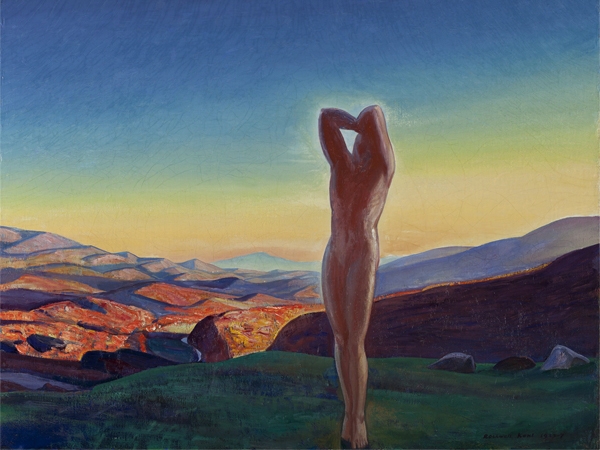
(Host) The artwork that the great American artist Rockwell Kent made
while living in Vermont is on display through October 30 at the
Bennington Museum. Veteran Vermont journalist and commentator Tom
Slayton visited the show recently and was excited by what he discovered.
(Slayton) In the late 1920s and early 30s, Rockwell Kent was
probably the most popular artist in America. His stark, mysterious
drawings, paintings, and prints seemed to be just about everywhere.
 But
But
Kent’s popularity faded with the change in artistic fashions that came
to America in the 40s and 50s. Non-figurative modes of art like abstract
expressionism became the latest new thing, and Kent’s mysticism and
social activism were suddenly passé. It should be noted that the
artist’s personality – his attraction to radical causes and to
attractive women he wasn’t wed to – probably also played a part in his
decline.
Nevertheless, Rockwell Kent’s art is as striking and
powerful today as when he created it – and he created some of his most
memorable pieces while he was living in Arlington, Vermont.
What
makes the current show at the Bennington Museum especially interesting
and important is that most biographies of Kent gloss over his Vermont
years as a time of artistic quiescence and suggest that his
adventure-loving personality didn’t take to the quiet rural landscape of
Vermont.
But nothing could be further from the truth, as the Bennington Museum show makes clear.
In
fact, the six years he lived in Arlington, from 1919 to 1925, appear to
have been pivotal in his career. He was there when he first attracted
national attention and wrote, after one show, “I find myself being
lauded as ‘the’ American artist.”
Perhaps most significantly,
some of his most striking paintings, prints and drawings were made while
he lived on an Arlington hill farm called “Egypt,” which had stunning
views of Bennington County and the southern Green Mountains in every
direction.
Not surprisingly, the paintings he made there were
often large landscapes. But these are landscapes with a message. Kent
used the spectacular views to create spiritual allegories, and said that
his work in those years was “a matter of evoking mood through
landscape.”
His winter scene, “The Trapper,” does just that,
capturing the chilly beauty and harsh realities of human survival in a
dramatic wintry landscape that focuses on the lone figure of a man
bearing a bloody fur. His painting “Nirvana,” strikes a gentler note: a
man and a woman recline meditatively against a rock with a vast panorama
of hills and farms spread out beyond them. An arc of shining clouds
across the sky suggests – in Rockwell’s own visual lexicon – a sense of
spiritual fulfillment.
More mysterious is the large painting
“Autumn,” in which a lone androgynous nude figure stands erect, hands
covering its face, while, behind it, range upon range of vividly
colored mountains march into the distance. Is the figure exulting in the
beauty of the scene or expressing anguish? It’s impossible to say.
What
can be said, however, is that this current show at the Bennington
Museum, “Rockwell Kent’s Egypt,” is a brilliant and captivating tribute
to this important artist’s important years in Vermont.